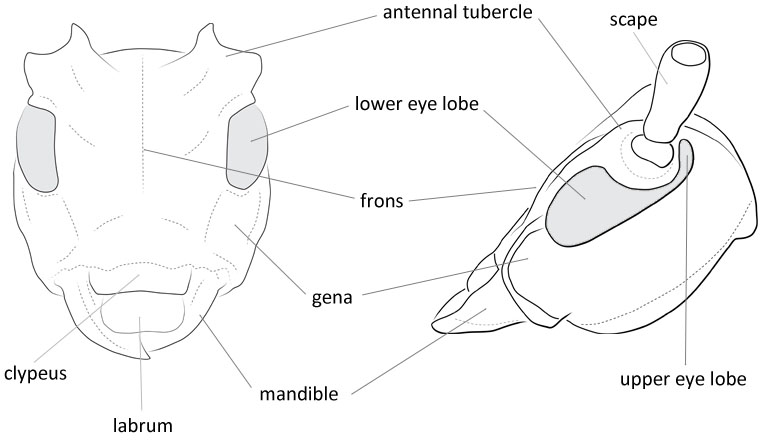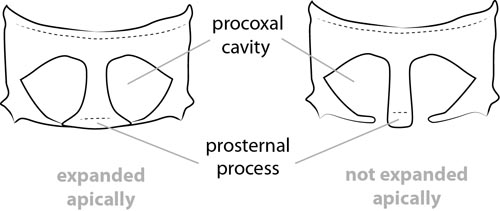Body length: 3–16 mm.
Eyes: eye interommatidial setaeseta:
a sclerotized hair-like projection of the cuticle
absent, eye deeply emarginateemarginate:
notched at the margin > half width or divided—max one row of facets between, eye ommatidial density fine.
> half width or divided—max one row of facets between, eye ommatidial density fine.
Antennaeantenna:
in larval and adult insects, paired segmented appendages, borne one on each side of the head, functioning as sense organs and bearing a large number of sensilla
: antennal length reaches between basebase:
the part of any appendage or structure that is nearest the body
and end of elytraelytron:
the leathery forewing of beetles, serving as a covering for the hind wings, commonly meeting opposite elytron in a straight line down the middle of the dorsum in repose
or reaching/surpassing end of body, antennal flagellar segments elongateelongate:
much longer than wide
, scapescape:
the first proximal segment of the antenna smooth/punctate at apexapex:
smooth/punctate at apexapex:
end of any structure distad to the base
, antennal scapescape:
the first proximal segment of the antenna ≥ segment 3 or segment 3 > scapescape:
≥ segment 3 or segment 3 > scapescape:
the first proximal segment of the antenna .
.
Pronotumpronotum:
the upper and dorsal part of the prothorax
: pronotumpronotum:
the upper and dorsal part of the prothorax
shape transversetransverse:
broader than long
or subquadratesubquadrate:
not quite a square
, pronotumpronotum:
the upper and dorsal part of the prothorax
lateral armature absent.
Prosternum: prosternal processprosternal process:
a posterior extension of the prosternum between the coxae not dilated at apexapex:
not dilated at apexapex:
end of any structure distad to the base
, procoxal cavities open posteriorly.
Elytraelytron:
the leathery forewing of beetles, serving as a covering for the hind wings, commonly meeting opposite elytron in a straight line down the middle of the dorsum in repose
: elytral length reaching or close to end of abdomen, elytral apicesapex:
end of any structure distad to the base
rounded or truncatetruncate:
cut off squarely at the tip
, rarely with tooth or spinespine:
a protuberance with an acute (sharp) distal end
, elytral color black, brown, metallic, reddish, or orange, elytral color pattern present or absent.
Legs: visible tarsomerestarsomere:
subdivision or article of the tarsus, usually numbering from two to five : 4, femora clavateclavate:
: 4, femora clavateclavate:
thickening gradually toward the tip
, protibial spursprotibial spur:
sclerotized spine(s) located at the distal tibia; can be single, double, or absent : 2, tarsal clawstarsal claw:
: 2, tarsal clawstarsal claw:
usually paired claws of the pretarsus, at the distal end of the leg simple.
simple.
Slender, subcylindrical, rarely flattened. Antennaeantenna:
in larval and adult insects, paired segmented appendages, borne one on each side of the head, functioning as sense organs and bearing a large number of sensilla
11-segmented and shorter than body in both sexes, second segment less than twice as long as broad; palpi very unequal. Pronotumpronotum:
the upper and dorsal part of the prothorax
rarely transversetransverse:
broader than long
, sides rounded, intercoxal process of prosternum short, narrow, pointed behind; mesosternummesosternum:
sternum of the mesothorax
broad, acutely triangular. Femora clavateclavate:
thickening gradually toward the tip
; first segment of posterior tarsitarsus:
the leg segment distal to the apex of the tibia, bearing the pretarsus; consists of one to five tarsomeres (including pretarsus)
slender, more than twice as long as broad (Linsley 1964Linsley 1964:
Linsley EG. 1964. The Cerambycidae of North America. Part V. Taxonomy and Classification of the Subfamily Cerambycinae, Tribes Callichromini Through Ancylocerini. University of California Publications in Entomology, Vol. 22. 197 pp.).
Eumichthus, Callidium, Meriellum
Phymatodes differs from most Callidiini in the prosternal processprosternal process:
a posterior extension of the prosternum between the coxae ending between the procoxaeprocoxa:
ending between the procoxaeprocoxa:
coxa of the front leg  . It can be differentiated from Callidium by the presence of a stridulatum and no large punctures on the mesonotum. Eumichthus looks similar but differs from Phymatodes by the second antennal segment more than twice as long as wide/about half as long as third, the final palpal segment triangularly dilated, and the male with the proleg tarsomerestarsomere:
. It can be differentiated from Callidium by the presence of a stridulatum and no large punctures on the mesonotum. Eumichthus looks similar but differs from Phymatodes by the second antennal segment more than twice as long as wide/about half as long as third, the final palpal segment triangularly dilated, and the male with the proleg tarsomerestarsomere:
subdivision or article of the tarsus, usually numbering from two to five 1 and 2 swollen.
1 and 2 swollen.
Holarctic, Indomalaya; P. (Phymatoderus) lividus introduced to USA, Argentina, Uruguay
Abies, Pinus, Larix, Picea, Pseudotsuga, Tsuga; Juniperus, Cupressus, libocedrus, Sequoia, Thuja, Chamaecyparis, Hesperocyparis macrocarpa (P. nitidus)
29 spp. (Phymatodes), 1 sp. (Melasmetus), 4 spp. (Paraphymatodes), 9 spp. (Phymatodellus), 9 spp. (Phymatoderus), 10 spp. (Poecilium). Conifers: P. (Phymatoderus) abietinus, P. (P.) glabratus, P. (Phymatodes) aeneus, P. (P.) testaceus, P. (P.) hirtellus, P. (P.) dimidiatus, P. (P.) fulgidus, P. (P.) hardyi, P. (P.) maculicollis, P. (P.) nigerrimus, P. (P.) nitidus,. P. testaceus is Holarctic.
Merium Kirby, 1837
Phymatodina Casey, 1912
Microcallidium Casey, 1912
Phymatodes Mulsant (not Dejean, 1834), 1839